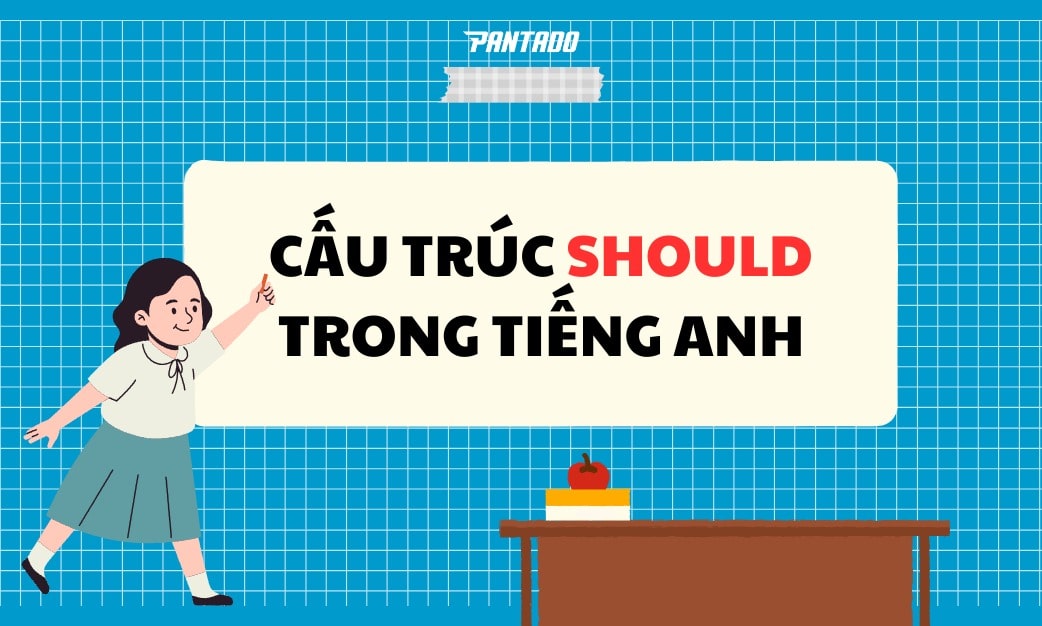Phát âm chuẩn
Cùng Pantado.edu.vn tìm hiểu các lới chúc thành công tiếng Anh yêu thương và ý nghĩa nhất đến những người thân yêu, bạn bè của mình qua bài viết dưới đây nhé!
Lời chúc thành công bằng tiếng Anh hay và ý nghĩa nhất

- Success doesn’t stand still and failure is not the end. It is important that we keep walking!
Thành công không ở yên và thất bại không phải là dấu chấm hết. Điều quan trọng là chúng ta dám bước đi! - Success is based on your own efforts. Never give up!
Thành công dựa trên chính nỗ lực của bạn. Đừng bao giờ bỏ cuộc! - Your efforts everyone can see. Keep the form to succeed soon
Những nỗ lực của bạn mọi người đều nhìn thấy. Hãy giữ vững phong độ để sớm thành công! - Nothing can describe my joy for you right now!
Không có điều gì có thể ngăn được niềm vui mà tôi dành cho bạn! - God will protect and guide you. Success will come to you soon!
Chúa sẽ che chở và dẫn lối cho bạn. Thành công sẽ đến với bạn sớm thôi! - For great success you must have big dreams!
Để thành công lớn bạn phải có những ước mơ lớn! - Maybe this stage is quite difficult. But we believe you will be successful. Try your best!
Có thể giai đoạn này sẽ khá khó khăn. Nhưng chúng tôi bạn sẽ thành công. Cố gắng hết sức mình nhé! - Trying may not be successful but not trying will inevitably fail. Wish you success on the path you have chosen!
Cố gắng chưa chắc đã thành công nhưng không cố gắng chắc chắn sẽ thất bại. Chúc bạn thành công trên con đường mình đã chọn! - Always be confident and win. You deserved it!
Hãy luôn tự tin và giành chiến thắng. Bạn xứng đáng với điều đó! - Difficulties will pass. Luckiness will come to you!
Khó khăn rồi sẽ qua đi. Điều may mắn sẽ đến với bạn!
>>> Có thể bạn quan tâm: Học tiếng Anh online miễn phí tốt nhất
Lời chúc thành công bằng tiếng Anh dành cho gia đình

- Do not worry. Our family and I are always watching and supporting you. Wishing you success on your way!
Đừng quá lo lắng. Gia đình này và em luôn dõi theo và ủng hộ chị. Chúc chị thành công trên con đường của mình! - You are starting a new project, right. I hope good things will come to you!
Anh trai em sắp bắt đầu một dự án mới đúng chứ. Em mong những điều tốt đẹp sẽ đến với anh! - See you grow and be as successful as you are today. This whole family is proud of you!
Chứng kiến con trưởng thành và thành công như ngày hôm nay. Cả gia đình này tự hào về con. - My little brother has grown up. I wish you will find your own path and succeed on the path you choose!
Em trai của chị đã lớn rồi. Chị chúc em sẽ tìm được lối đi riêng cho mình và thành công trên con đường mà em chọn! - You may not be the best. But you are always the best effort. I believe you will achieve certain results on your own!
Em có thể không phải là người giỏi nhất. Nhưng em luôn nỗ lực hết mình. Chị tin rằng sẽ sẽ tự mình đạt được những kết quả nhất định của riêng mình!
Lời chúc thành công bằng tiếng Anh dành cho bạn bè
- To get where you are now, you must have gone through a lot of ups and downs. Stay on track, my friend!
Để có được vị trí như bây giờ, chắc hẳn bạn đã phải trải qua rất nhiều thăng trầm. Giữ vững phong độ nhé, bạn của tôi! - You do everything very well. And this time too. You do very well. Congratulations!
Bạn làm mọi việc rất tốt. Và lần này cũng vậy. Chúc mừng! - You have been working so hard to get the fruit you are today. Wish you more and more success!
Bạn đã rất nỗ lực để có được thành quả như ngày hôm nay. Chúc bạn thành công hơn nữa! - I heard you are about to start a company. I Hope your company develops well!
Tôi nghe nói bạn sắp thành lập công ty. Chúc công ty của bạn làm ăn phát đạt - You have just been promoted, right. Congratulations on your success with my best feelings!
Bạn mới được thăng chức đúng chứ. Chân thành chúc mừng nhé! - Your dreams have finally come true. I’m glad for you!
Những ước mơ của bạn đã thành sự thật. Tôi lấy làm vui mừng cho bạn! - You know to seize the opportunity. In the future you will become a wonderful man. Wish you a breakout soon!
Bạn là người biết nắm bắt cơ hội. Tương lai bạn sẽ trở thành người tuyệt vời. Chúc bạn sớm bứt phá! - You have always been so elite. I really admire your current success!
Bạn luôn ưu tú như vậy. Tôi thật sự ngưỡng mộ thành công của bạn - Hearing the news of your success, I was overjoyed. Congratulations on your efforts paid off!
Nghe tin bạn thành công tôi vui mừng khôn xiết. Chúc mừng những nỗ lực của bạn đã được báo đáp! - I can’t believe my friend. You are fantastic. I Hope your success will go further!
Thật không thể tin được bạn của tôi. Bạn thật tuyệt vời. Chúc thành công của bạn sẽ tiến xa hơn nữa!
Lời chúc thành công bằng tiếng Anh dành cho đồng nghiệp

- You are making a big turning point in your life. With your current endeavors I believe you will be great!
Bạn đang đứng trên một bước ngoặt lớn của cuộc đời. Với sự nỗ lực của bạn tôi tin bạn sẽ trở nên xuất sắc! - Welcome to become my colleague. I Hope you adapt soon and have excellent working results!
Chào mừng bạn đã trở thành đồng nghiệp của tôi. Chúc bạn sớm thích nghi và có kết quả làm việc xuất sắc! - Tomorrow is better than today. you of tomorrow will be more successful than you of today!
Ngày mai sẽ tốt hơn ngày hôm nay. Bạn của ngày mai sẽ thành công hơn bạn của ngày hôm nay! - Your success has been amazing. We admire you very much!
Thành công của bạn thật tuyệt vời. Chúng tôi rất ngưỡng mộ bạn! - The first steps will be difficult but you are very resilient. Success will find you!
Những bước đi đầu tiên sẽ khó khăn nhưng bạn rất kiên cường. Thành công sẽ tìm đến bạn. - You are an excellent employee. With a positive expression, you will be promoted soon.
Bạn là một nhân viên xuất sắc. Với những biểu hiện tích cực, bạn sẽ sớm được thăng chức thôi! - You did an excellent job. Congratulations on your success!
Bạn đã có một công việc tuyệt vời. Chúc mừng vì thành công của bạn! - Failure will help you grow. Success also comes out!
Đi lên từ thất bại sẽ giúp bạn trưởng thành hơn. Thành công cũng từ đó mà xuất hiện! - I am very happy to know you got a promotion. Wish you more and more success!
Tôi rất lấy làm vui mừng khi biết bạn thằng trức. Chúc bạn thành công hơn nữa! - You did an excellent job. Congratulations on your success!
Bạn đã có một công việc tuyệt vời. Chúc mừng vì thành công của bạn! - The harder the job is, the harder you have to try. Good luck!
Công việc càng khó khăn thì bạn càng phải cố gắng. Chúc bạn may mắn!
Những câu thành công bằng tiếng Anh thông dụng khác
- “It’s how you deal with failure that determines how you achieve success”: Chính cách bạn xử trí thất bại quyết định cách bạn đạt được thành công.
- “Where there is a will, there is a way”: Nơi nào có ý chí, nơi đó có con đường
- “Success isn’t final, failure isn’t fatal: it’s the courage to continue that counts”: Thành công không phải là kết quả cuối cùng, thất bại cũng không phải đường cùng, bạn can đảm đi tiếp mới là điều quan trọng nhất
- “To be a winner, all you need to give is all you have”: Để trở thành người chiến thắng, bạn cần phải làm là cho đi tất cả những gì bạn có
- “When life changes to be harder, change yourself to be stronger”: Khi cuộc sống trở nên khó khăn hơn, hãy thay đổi bản thân để trở nên mạnh mẽ hơn
>>> Mời xem thêm: Tổng hợp 100 câu châm ngôn tiếng Anh hay nổi tiếng nhất!
Gần đây tin tức đưa tin mạng xã hội Facebook và ông trùm Mark Zuckerberg nhiều lần bị buộc tội theo dõi và khai thác dữ liệu cá nhân của người dùng. Bạn sẽ nói câu văn này bằng tiếng Anh như thế nào nhỉ? Cấu trúc Accuse dùng để buộc tội trong tiếng Anh. Hãy theo dõi đến cuối bài viết này để nắm được chi tiết về cách dùng cấu trúc Accuse nhé!
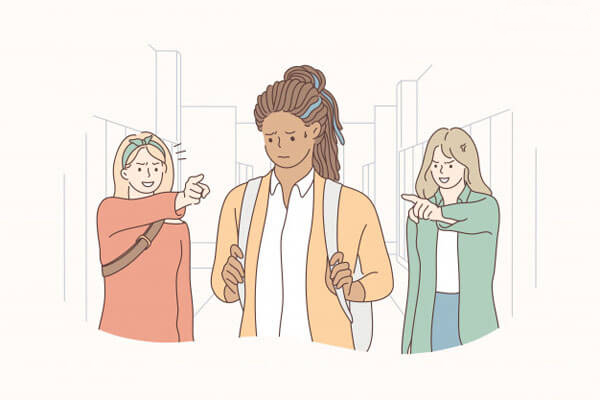
Accuse nghĩa là gì?
Trong tiếng Anh, động từ Accuse mang nghĩa là kết tội, buộc tội hoặc tố cáo ai đó. Người bị kết tội trực tiếp gây ra sự việc đó.
Ví dụ:
She accused Tom of stealing her money. / (Cô ấy đã tố cáo Tom trộm tiền của cô ấy.)
Ngoài ra, khi được thêm đuôi “d”, danh từ Accused có nghĩa là bị cáo, người/ những người bị tố cáo, kết tội.
Ví dụ:
The accused had a lawyer to defend him. / (Bị cáo có một luật sư để bào chữa cho anh ta.)
Cấu trúc Accuse
Cấu trúc Accuse trong câu được dùng theo hai dạng: dạng chủ động và dạng bị động.
Dạng chủ động:
S + Accuse + O + of + Noun/ V-ing
Khi ở dạng chủ động, cấu trúc Accuse được sử dụng khi người nói buộc tội, tố cáo ai đó đã làm gì.
Ví dụ:
- Jane accused him of telling lies and cheating on her. / (Jane tố cáo anh ta tội nói dối và lừa dối cô ấy.)
- Many politicians accused him of corruption. / (Nhiều chính trị gia đã tố cáo anh ta tội tham nhũng.)
>>> Có thể bạn tâm: học tiếng anh miễn phí với người nước ngoài
Dạng bị động
S + be accused of Noun/ V-ing
Khi chuyển sang dạng bị động, cấu trúc Accuse diễn tả việc ai đó bị buộc tội, kết tội gì.
Ví dụ:
- Peter is accused of driving after drinking alcohol and attacking the policeman. / (Peter bị tố cáo tội lái xe sau khi sử dụng đồ uống có cồn và tấn công viên cảnh sát.)
- The city mayor was accused of money-laundering two week ago. / (Viên thị trưởng thành phố bị buộc tội rửa tiền hồi hai tuần trước.)
Cấu trúc Blame. Phân biệt cấu trúc Accuse và Blame
Trong tiếng Anh, chúng ta còn có động từ Blame cũng mang nghĩa là buộc tội, tố cáo. Do vậy, hai cấu trúc Accuse và Blame thường gây nhầm lẫn cho người học. Cùng tìm hiểu về cấu trúc Blame và cách phân biệt hai cấu trúc dưới đây nhé!
Cấu trúc Blame
Cấu trúc Blame diễn tả việc đổ tội/ đổ lỗi 1 ai đó cho việc gì, người bị đổ lỗi không trực tiếp gây ra sự việc/ vụ việc đó.
Tương tự như Accuse, cấu trúc Blame cũng được chia làm hai dạng, chủ động và bị động
Dạng chủ động:
S + Blame + O + for + Noun/ V-ing (Đổ lỗi cho ai về việc gì)
S + Blame + Noun + on + O (Đổ lỗi việc gì lên ai đó)
Ví dụ:
- She blamed me for the car accident. / (Cô ấy đã đổ lỗi cho tôi về vụ tai nạn xe hơi.)
- She blamed the car accident on me. / (Cô ấy cho rằng vụ tai nạn xe hơi là lỗi do tôi.)
Dạng bị động:
S + to be blamed for + Noun/ V-ing (Ai đó bị đổ lỗi vì việc gì)
Ví dụ:
I was blamed for causing the car accident. / (Tôi bị đổ lỗi rằng đã gây ra vụ tai nạn xe hơi đó.)

Bài tập cấu trúc Accuse
Chọn từ chính xác để hoàn thiện câu văn.
- His old boss accuses him of (selling/ sold/ sell) the company information.
- The (accusing/ accused/ accuse) sat impassively as the judge sentenced him to ten years in prison.
- He has been (accused/ accusing/ blamed) of spying.
- She practically (accused me on/ accused me for/ accused me of) starting the fire!
- Hoa blames herself (for/ at/ of) what has happened.
- I don’t blame you for (being/ be/ had been) angry.
- The conductor is ( blamed on/blamed for/ accused for) the accident.
- He was accused (of stealing/ on stealing/ for stealing) a small boy’s bicycle.
- The guilt of (the accusing/ the accused/ the accuse) man was in doubt.
- She clearly (accused/ accuse/ blamed) me personally for the difficulties she’d been having.
Đáp án:
- His old boss accuses him of selling the company information.
- The accused sat impassively as the judge sentenced him to ten years in prison.
- He has been accused of spying.
- She practically accused me of starting the fire!
- Hoa blames herself for what has happened.
- I don’t blame you for being angry.
- The conductor is blamed for the accident.
- He was accused of stealing a small boy’s bicycle.
- The guilt of the accused man was in doubt.
- She clearly blamed me personally for the difficulties she’d been having.
>>> Mời xem thêm: Cách dùng cấu trúc Should trong tiếng Anh
Cấu trúc “should” trong tiếng Anh chắc hẳn khá quen thuộc trong việc đưa ra lời khuyên. Tuy nhiên, “should” là một điểm ngữ pháp đa dạng cấu trúc mà không phải ai cũng biết. Vì thế, bài viết này sẽ giúp bạn hiểu rõ hơn các kiến thức liên quan đến "should" và công thức, cách dùng kèm ví dụ, bài tập thực hành giúp bạn vận dụng tốt và nâng cao kĩ năng tiếng Anh.
1. "Should" nghĩa là gì?
"Should" là một động từ khuyết thiếu (modal verb) có nghĩa là “nên”, được dùng để thể hiện lời khuyên, nghĩa vụ, sự dự đoán hoặc giả định về một sự việc nào đó.
Cấu trúc tổng quát:
|
S + should + V_inf |
Ví dụ:
- You should sleep early to stay healthy. (Bạn nên ngủ sớm để giữ gìn sức khỏe.)
- He should apologize for his lie. (Anh ấy nên xin lỗi vì lời nói dối của anh ấy.)
2. Cấu trúc và cách dùng "Should"
2.1. Cấu trúc chung
a. Khẳng định
Cấu trúc “Should” trong thể khẳng định dùng để đưa ra lời khuyên hoặc gợi ý cho sự việc gì đó.
Cấu trúc:
|
S + should + V-inf + ... |
Ví dụ:
- You should drink more water. (Bạn nên uống nhiều nước hơn.)
- She should apologize to her friend. (Cô ấy nên xin lỗi bạn mình.)
- We should go now before it gets dark. (Chúng ta nên đi ngay trước khi trời tối.)
b. Phủ định
Cấu trúc “Should” trong thể phủ định dùng để nói về điều không nên làm.
Cấu trúc:
|
S + should not (shouldn’t) + V-inf + ... |
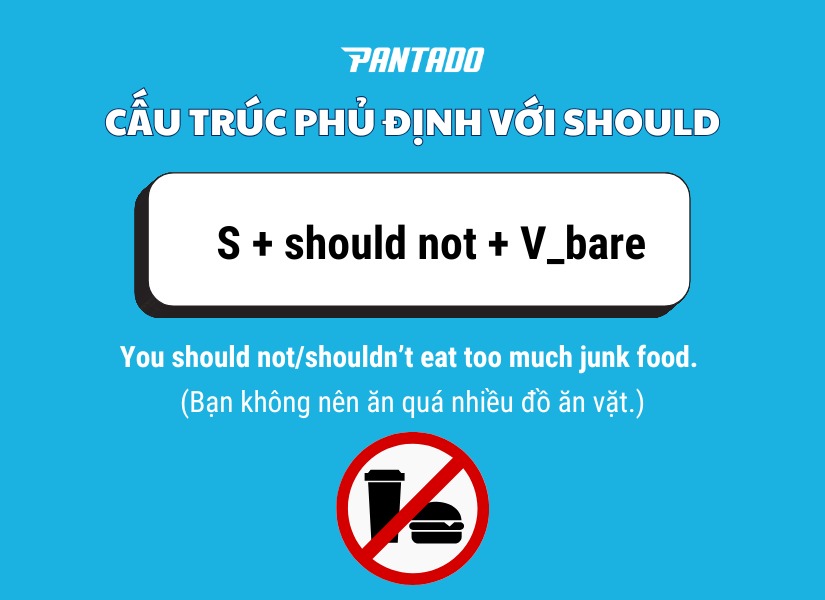
Cấu trúc phủ định với “Should”
Ví dụ:
- You shouldn’t eat too much junk food. (Bạn không nên ăn quá nhiều đồ ăn vặt.)
- He shouldn’t be rude to his colleagues. (Anh ấy không nên thô lỗ với đồng nghiệp.)
- We shouldn’t waste time on unimportant things. (Chúng ta không nên lãng phí thời gian vào những thứ không quan trọng.)
c. Nghi vấn
Cấu trúc “Should” trong thể nghi vấn dùng để xin lời khuyên hoặc ý kiến.
Cấu trúc:
|
Should + S + V-inf + ...? |
Ví dụ:
- Should I buy this laptop? (Tôi có nên mua chiếc laptop này không?)
- Should we take a taxi or walk? (Chúng ta nên đi taxi hay đi bộ?)
- Should he apologize for his mistake? (Anh ấy có nên xin lỗi vì lỗi lầm của mình không?)
>> Tham khảo: Must là gì? Cấu trúc với Must
2.2. Cấu trúc Should be V-ing
Cấu trúc Should be V-ing dùng để diễn tả một hành động lẽ ra nên đang xảy ra ở thời điểm hiện tại hoặc một thời gian cụ thể.
Cấu trúc:
|
S + should be + V-ing + ... |
Ví dụ:
- You should be studying right now instead of playing games. (Bạn đáng lẽ nên học ngay bây giờ thay vì chơi game.)
- They should be arriving at the airport by now. (Họ có lẽ đã đến sân bay vào lúc này.)
2.3. Cấu trúc Should have V3 (Quá khứ phân từ)
Cấu trúc Should have V3 dùng để diễn tả sự hối tiếc về một hành động đã không xảy ra trong quá khứ (lẽ ra nên làm gì nhưng không làm).
Cấu trúc:
|
S + should have + V3 + ... |
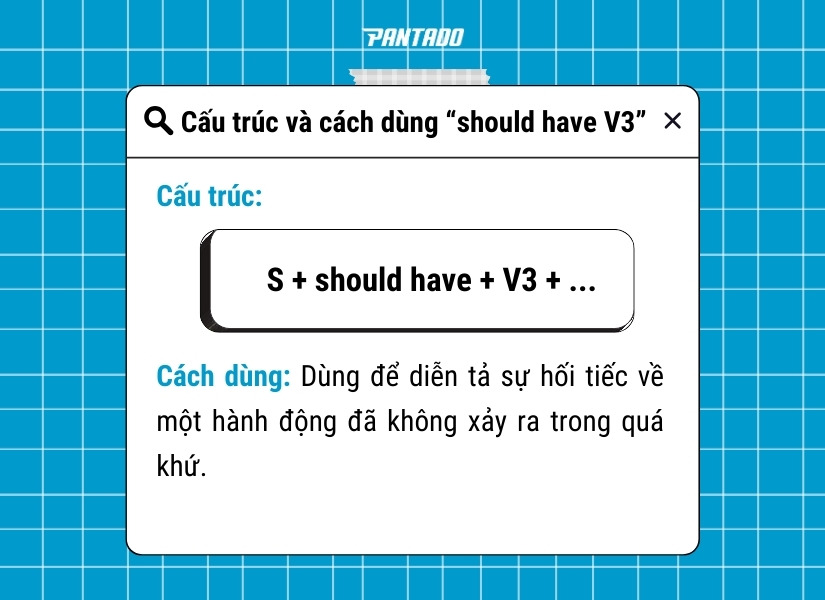
Cấu trúc và cách dùng “should have V3”
Ví dụ:
- I should have studied harder for the exam. (Lẽ ra tôi nên học chăm hơn cho kỳ thi.)
- You should have called me earlier. (Lẽ ra bạn nên gọi cho tôi sớm hơn.)
- They should have left earlier to avoid traffic. (Lẽ ra họ nên đi sớm hơn để tránh tắc đường.)
2.4. Cấu trúc Should + S + V (Đảo ngữ câu điều kiện loại 1)
Câu điều kiện loại 1 thường diễn tả một điều kiện có thể xảy ra ở hiện tại hoặc tương lai, với khả năng thực tế cao. Khi sử dụng đảo ngữ, chúng ta bỏ "if" và đưa "should" lên đầu câu để làm cho câu trang trọng hơn.
Cấu trúc:
|
Should + S + V-inf, S + will/can/may + V |
Ví dụ:
- If it rain tomorrow, we will cancel the trip. → Should it rain tomorrow, we will cancel the trip. (Nếu ngày mai trời mưa, chúng tôi sẽ hủy chuyến đi.)
- If he call me, I will tell him the news. → Should he call me, I will tell him the news. (Nếu anh ấy gọi cho tôi, tôi sẽ báo tin cho anh ấy.)
- If you change your mind, let me know. → Should you change your mind, let me know. (Nếu bạn đổi ý, hãy báo cho tôi biết.)
3. Phân biệt “Should”, "Ought To" và "Had Better"
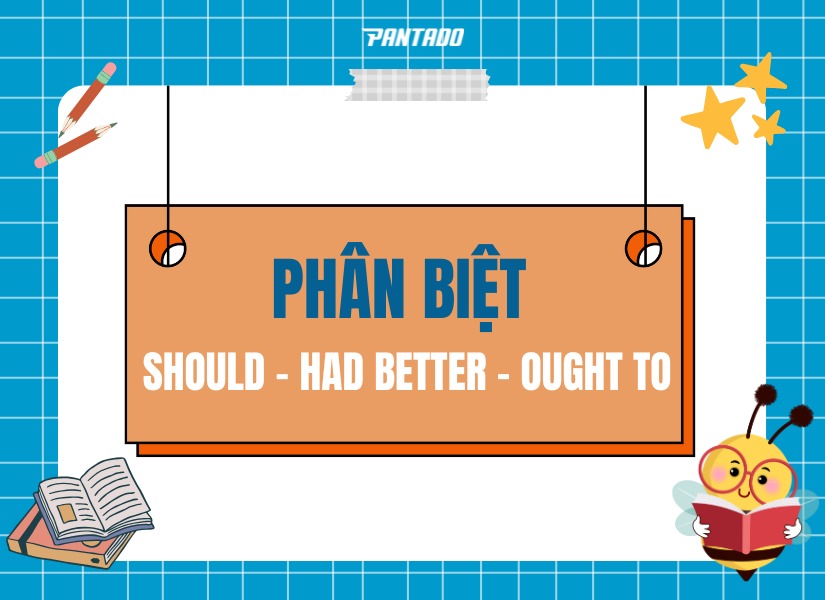
Cách phân biệt “should”, “had better” và “ought to” trong tiếng Anh
|
Tiêu chí |
Should |
Had Better |
Ought To |
|
Ý nghĩa |
Đưa ra lời khuyên, gợi ý nhẹ nhàng. |
Đưa ra lời khuyên mạnh mẽ với hàm ý cảnh báo về hậu quả nếu không làm theo. |
Mang ý nghĩa khuyên nhủ tương tự "Should" nhưng trang trọng hơn, có hàm ý là không thể còn cách nào khác hơn là phải (làm gì đó), mang tính giải pháp. |
|
Mức độ |
Không bắt buộc, chỉ là lời khuyên. |
Mạnh hơn "should", nếu không làm có thể có hậu quả tiêu cực. |
Khuyến khích mạnh mẽ hơn "should" nhưng vẫn không bắt buộc. |
|
Cấu trúc |
Should + V-inf |
Had better + V-inf |
Ought to + V-inf |
|
Phủ định |
Shouldn’t + V |
Had better not + V |
Ought not to + V |
>>> Mời xem thêm: Cách phân biệt A number of và The number of trong tiếng Anh
4. Bài tập vận dụng
Bài tập 1: Chọn câu trả lời đúng trong các câu dưới đây
1. You ________ drive carefully when it's foggy.
a) should
b) must
c) ought to
2. He ________ have studied harder, but he was too lazy.
a) should
b) should have
c) shouldn’
3. We ________ be more understanding towards others.
a) should
b) must
c) shouldn’t
4. You ________ have spoken to her like that. It was rude.
a) should
b) shouldn’t
c) should have
5. They ________ left earlier to avoid the traffic jam.
a) should
b) must
c) should have
(Đáp án: 1-a, 2-b, 3-a, 4-b, 5-c.)
Bài tập 2: Hãy chọn đáp án đúng để hoàn thành các câu sau
1. You _______ (should/ought to/had better) see a doctor if you’re feeling sick.
2. He _______ (should have/ought to have/had better have) told the truth.
3. We _______ (should/ought to/had better) leave early to avoid traffic.
4. They _______ (should/ought to/had better) not have ignored the warnings.
5. You _______ (should/ought to/had better) call her now before she leaves.
Đáp án:
1. should
2. ought to have
3. had better
4. should
5. had better
5. Kết luận
Hy vọng bài viết này của Pantado đã giúp bạn hiểu rõ hơn về các cách dùng của cấu trúc “Should” thường gặp. Hãy thực hành thường xuyên để nắm chắc kiến thức và giao tiếp tiếng Anh tự nhiên hơn nhé. Theo dõi website pantado.edu.vn để cập nhật thêm nhiều kiến thức hữu ích khác.
>> Có thể bạn quan tâm: Tiếng Anh trực tuyến 1 kèm 1 cho bé uy tín, chất lượng
Có lẽ cụm từ Interested in đã quen thuộc với chúng ta, nó mang nghĩa là thích thú, quan tâm đến điều gì.Trong khi Like, Enjoy, Love và Adore cũng có nghĩa là thích, yêu thích.Tuy nhiên cách dùng của chúng lại không giống nhau. Bài viết dưới đây sẽ giúp bạn tìm hiểu cấu trúc Interested in và so sánh các cấu trúc Interested in, Like, Enjoy, Love, Adore, Be fond of, Be keen on trong tiếng Anh nhé!
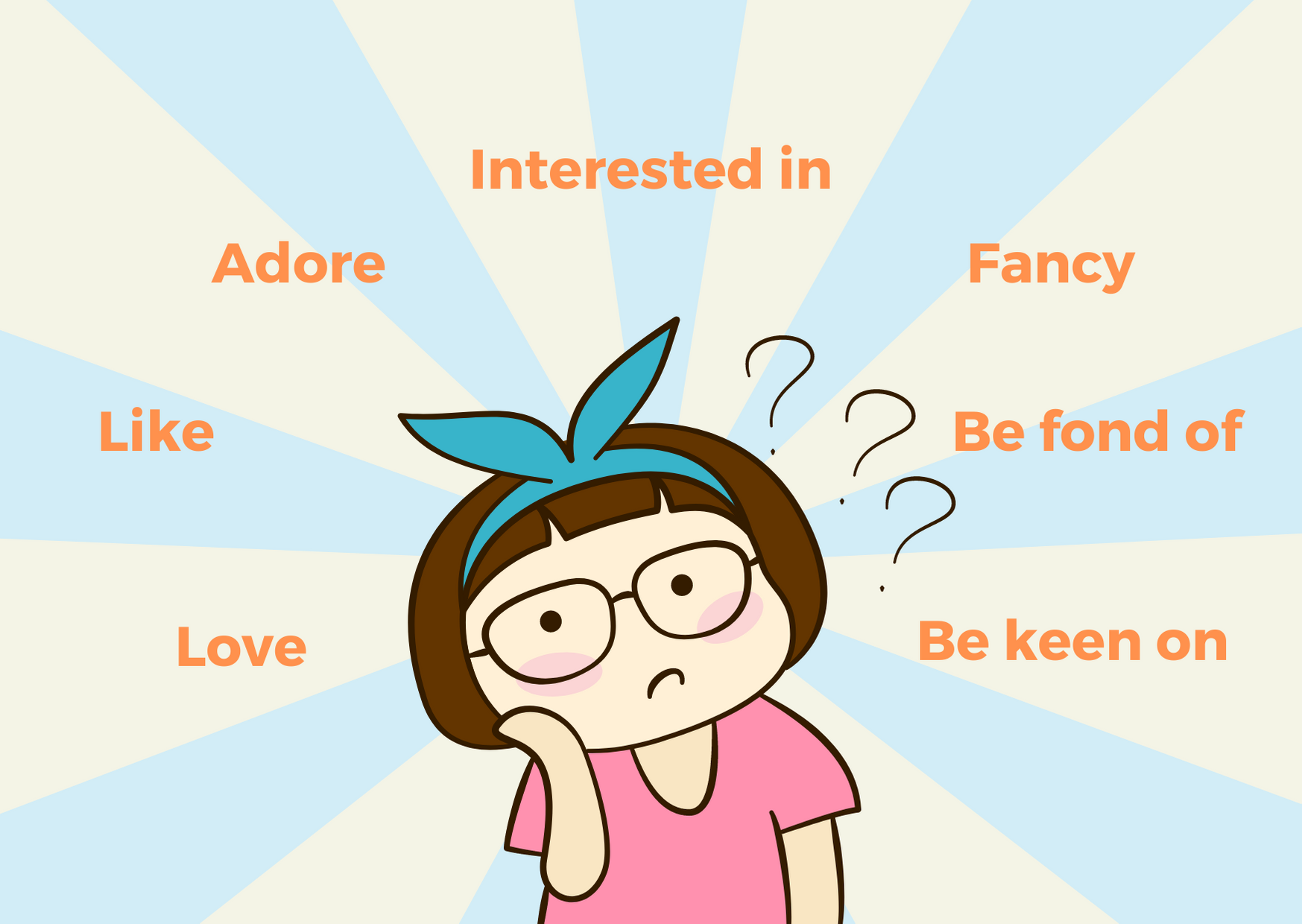
Cấu trúc Interested in
Trong tiếng Anh, cấu trúc Interested in được sử dụng để diễn tả sự yêu thích, quan tâm, hứng thú đối với một đối tượng cụ thể nào đó.
Ví dụ:
I’m interested in Philosophy, Literature and Psychology. / (Tôi thích môn triết học, văn học và lịch sử.)
Khi sử dụng trong các câu văn cụ thể, interested in đứng sau động từ tobe và trước một danh từ hoặc danh động từ (V-ing)
Cấu trúc:
S + tobe + interested in + Noun/ V-ing
Ví dụ:
- The politician’s son was not interested in politics. / (Con trai của nhà chính trị gia không hứng thú với chính trị.)
- He is more interested in exploring the world than waiting long enough to see what happened. / (Anh ấy thích việc khám phá thế giới hơn là chờ đợi đủ lâu để xem thứ gì xảy ra.)
So sánh các cấu trúc diễn tả sự yêu thích
Cấu trúc Like
- Like mang nghĩa là thích, thường sử dụng trong những tình huống chung chung, không cụ thể.
- Like là một cảm xúc thích thú đơn giản, thường đến rất nhanh, tuy nhiên chúng có thể duy trì lâu dài hoặc không. Đây là đặc điểm phân biệt like với love (tình yêu mãnh liệt, lãng mạn), adore (tình yêu với sự say mê, ngưỡng mộ, tôn kính), và be fond of (thích một người đã biết nhau lâu rồi).
- Động từ Like miêu tả cảm giác dễ chịu, hài lòng về điều được nói đến. Điều này cũng khác với động từ enjoy, được dùng khi bạn có được cảm giác hài lòng, nhận được niềm vui từ điều gì đó.
Ví dụ:
- I like my experiences here = I think my experience here is very good. / (Tôi nghĩ những trải nghiệm của tôi rất tốt.)
- I enjoy my experience here = I have satisfaction from my experience here. / (Tôi hài lòng với những trải nghiệm của mình ở đây.)
Cấu trúc Enjoy
- Động từ Enjoy được dùng khi bạn cảm thấy hài lòng, vui vẻ, thích thú bởi những thứ bạn đã làm hay trải qua. So với like và love thì enjoy nhấn mạnh sự tận hưởng hơn.
Ví dụ: She really enjoyed her holiday in Nha Trang. / (Cô ấy đã thực sự tận hưởng kỳ nghỉ ở Nha Trang.)
- Khác với like, love, adore, fancy, be fond of, be keen on, be interested in thì enjoy không được dùng để nói thích ai đó.
- Động từ enjoy còn được sử dụng để diễn tả rằng bạn hi vọng người đó sẽ thích thứ mà bạn gợi ý cho họ, có thể là tặng, mời, đọc, xem hoặc thưởng thức.
Ví dụ: This is your concert ticket. I hope that you will enjoy it. / (Đây là vé xem biểu diễn của bạn. Mình hi vọng bạn sẽ thích nó.)
>>> Có thể bạn quan tâm: chương trình học tiếng anh online cho trẻ em
Cấu trúc Love
- Từ love nhấn mạnh yếu tố lãng mạn trong tình yêu. Nó thường là cảm xúc thu hút mạnh mẽ, dựa trên ham muốn tình dục và có nhu cầu được ràng buộc gắn bó với người đó. Trong khi đó, like chỉ là cảm xúc quý mến ai đó. Do đó, love có cảm xúc mạnh hơn like.
Ví dụ: This is my wife. I love her so much. / (Đây là vợ tôi. Tôi yêu cô ấy rất nhiều.)
- Love có xu hướng nói đến một tình cảm nghiêm túc, kéo dài trong khoảng thời gian trung đến dài hạn. Ngược lại, like, fancy là một cảm xúc thích thú, ham muốn đơn giản, thường đến rất nhanh, có thể duy trì lâu dài hoặc không.
- Love còn được dùng để nói đến tình yêu giữa các thành viên trong gia đình hay bạn bè. Với cách dùng này, love tương tự adore. Tuy nhiên, adore lại nhấn mạnh yếu tố ngưỡng mộ và tôn kính hơn.
Ví dụ: I love/adore my parents because they have worked so hard to raise me. / (Tôi rất yêu bố mẹ mình vì họ đã làm việc rất vất vả để nuôi tôi khôn lớn.)
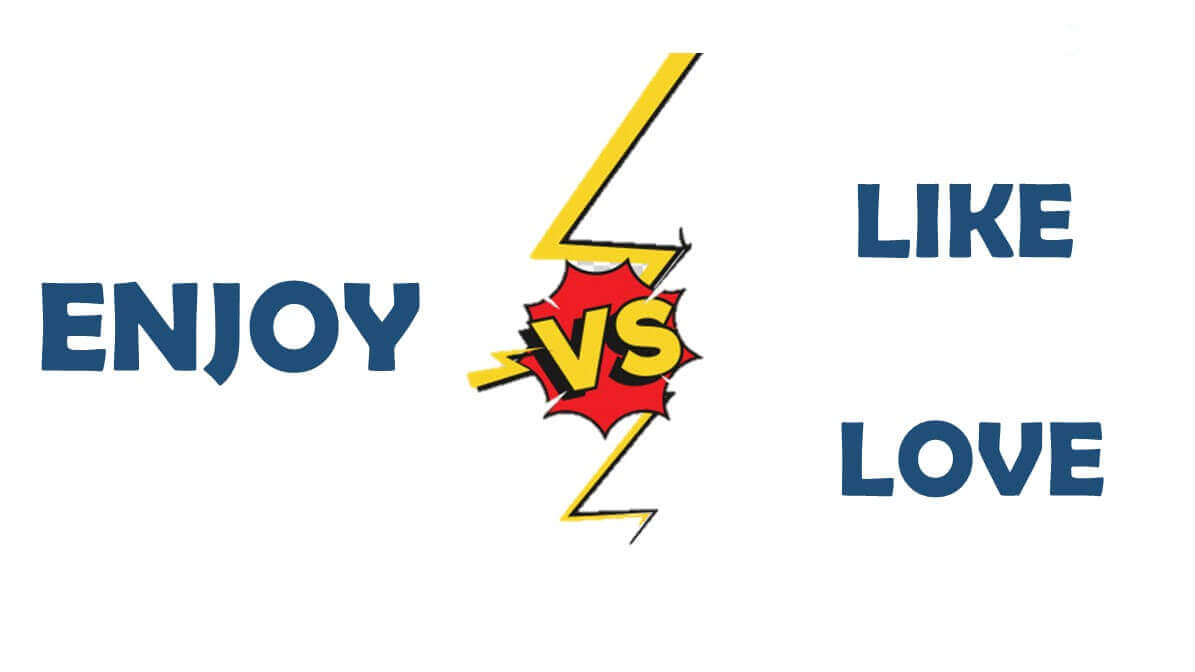
Cấu trúc adore
- Adore trong tiếng Anh có nghĩa là yêu và tôn trọng ai đó rất nhiều; hoặc thích cái gì đó rất nhiều
- Adore diễn đạt tình cảm mãnh liệt, say mê đắm đuối và tận tụy, theo cái cách cho thấy sự ngưỡng mộ hoặc tôn kính người đó. Trong khi Love lại nhấn mạnh yếu tố lãng mạn, nồng nàn giữa những người yêu nhau hay một mối quan hệ gắn bó như ba mẹ, con cái, vợ chồng. Ngoài ra, so với love, adore thường được sử dụng trong ngữ cảnh không trang trọng, thường được thấy trong lời bài hát hay thơ văn.
- Adore, với nghĩa trang trọng, còn để nói đến sự tôn thờ, sùng bái thần thánh. Đặc điểm này phân biệt adore với like, enjoy, love, fancy, be fond of, be keen on, be interested in.
- Adore còn được dùng để nói thích ai theo kiểu thần tượng ai đó (ca sĩ, diễn viên).
Ví dụ: Benedict Cumberbatch is a talented actor. We adore him. / (Benedict Cumberbatch là một nam diễn viên tài năng. Chúng tôi thần tượng anh ấy.)
Cấu trúc Fancy
- Trong tiếng Anh, Fancy nghĩa là muốn điều gì hoặc bị thu hút bởi ai đó.
Ví dụ: I fancy a cup of bubble tea. / (Tôi muốn một cốc trà sữa.)
- Fancy thường được dùng trong Anh-Anh. Trong Anh-Mỹ, mọi người có xu hướng dùng want to hơn.
- Fancy someone có nghĩa rằng bạn bị thu hút bởi ai đó. Mức độ thích cao hơn like someone. Cách dùng này được sử dụng như be keen on.
Ví dụ: She knew he fancies her, but she didn’t give him any chance. / (Cô ấy biết anh ta thích mình, nhưng cô không cho anh ta cơ hội nào.)
- Fancy yourself để nói rằng bạn tự cho là mình đẹp, thông minh, nổi tiếng. Trong khi đó, enjoy yourself để nói rằng bạn có được niềm vui từ việc mà bạn đang làm.
Cấu trúc Be Fond Of
- Be fond of diễn tả cảm xúc thích một ai đó rất nhiều, đặc biệt khi bạn đã biết họ trong thời gian lâu.
- Trong khi like someone để nói đến cảm giác thích, hoặc quý mến ai đó một cách nhanh chóng thì be fond of someone thể hiện tình cảm mạnh hơn, thích rất nhiều, nhấn mạnh việc bạn đã biết người này một thời gian khá lâu, đã gặp gỡ, nói chuyện nhiều lần.
Ví dụ: I am fond of the boy next door. He has helped me a lot since I moved to this area. / (Tôi thích chàng trai nhà bên. Anh ấy đã giúp tôi rất nhiều từ khi tôi chuyển đến khu vực này.)
- Bên cạnh đó, so với love someone, thì be fond of someone thể hiện tình cảm nhẹ hơn. Nó không thể hiện được sự lãng mạn, thân mật trong tình yêu, và cũng không có sự ràng buộc. Nó cũng khác với sự yêu thích theo kiểu tôn sùng, ngưỡng mộ như adore someone.
- Ngoài ra, be fond of còn mang nghĩa là thích làm điều mà người khác cảm thấy khó chịu, không hài lòng. Các từ like, enjoy, love, adore, fancy, be keen on, be interested in không có nét nghĩa này.
Ví dụ: My boss is fond of forcing employees work overtime. / (Sếp của tôi thích ép buộc nhân viên làm thêm giờ.)
Cấu trúc Be Keen On
- Be keen on diễn tả cảm xúc mong muốn làm việc gì hoặc rất mong việc đó sẽ xảy ra. Nó nhấn mạnh sự nhiệt tình, hăng hái, háo hức và sẵn sàng tham gia hoạt động đó. Đặc điểm này phân biệt be keen on với like và enjoy (thích làm một việc gì đó bởi vì cảm thấy vui), be fond of (thích làm việc đã quen thuộc trong khoảng thời gian lâu).
Ví dụ: She is not keen on going to the super market at weekend. / (Cô ấy không hăng hái đi siêu thị vào cuối tuần.)
- Khi nói be keen on somebody, có nghĩa rằng bạn bị người đó thu hút, theo kiểu “sexual attraction”. Đối với nghĩa này, ta có thể sử dụng be keen on như fancy.
Ví dụ: I am keen on a girl who work in the library. / (Tôi thích một cô gái làm việc ở thư viện.)
- Be keen on thường được sử dụng trong câu phủ định.
Cấu trúc Interested In
- Be interested in được dùng để nhấn mạnh mong muốn tìm hiểu /khám phá nhiều hơn về ai đó/ việc gì đó. Đặc điểm này phân biệt be interested in với be keen on (nhấn mạnh sự hăng hái, nhiệt tình, muốn làm), hay be fond of (nhấn mạnh khoảng thời gian thích từ lâu).
Ví dụ: I am interested in Marketing. I want to delve into this in the future. / (Tôi có hứng thú với Marketing. Tôi muốn tìm hiểu sâu hơn về nó trong tương lai.)
>>> Mời xem thêm: Cấu trúc “Try” trong tiếng Anh chi tiết nhất
“Try hard” có lẽ là cụm từ chúng ta gặp nhiều và quen thuộc nhất. Cụm từ này mang nghĩa là gì nhỉ? Chúng ta cùng tìm hiểu cấu trúc Try một cách chi tiết nhất nhé!
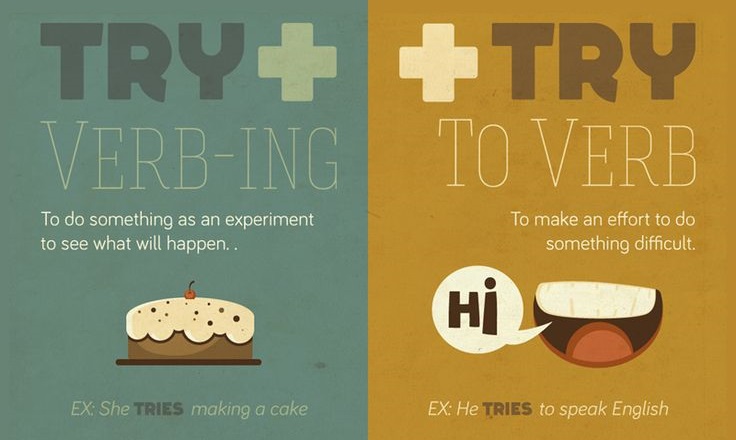
Try nghĩa là gì?
Trong tiếng Anh, try mang nghĩa là cố gắng, nỗ lực.
Như vậy, cụm từ “Try hard” được nhắc đến ở phía trên mang nghĩa là cố gắng rất nhiều. Đây là thuật ngữ ám chỉ hành động cày cuốc ngày đêm, thường gắn với các game thủ.
Một cụm từ cũng mang nghĩa tương tự “Try hard” nhưng hay xuất hiện hơn là “Try one’s best”.
Ví dụ:
They tried their best to win the contest. / (Họ đã cố gắng hết sức để thắng cuộc thi.)
Ngoài ra, động từ try còn mang nghĩa là thử, kiểm tra một thứ gì đó
Ví dụ:
Many customers have tried our new products and gave positive feedback. / (Rất nhiều khách hàng đã dùng thử sản phẩm mới của chúng tôi và đưa ra phản hồi tích cực.)
>>> Có thể bạn quan tâm: học tiếng anh trực tuyến dành cho trẻ em
Cấu trúc Try trong tiếng Anh
Cấu trúc 1
- Khi try mang nghĩa là cố gắng, nỗ lực làm gì đó, theo sau nó sẽ là dạng động từ nguyên thể có to (To V)
Cấu trúc:
S + Try + To V
Ví dụ:
- He is trying to remember all the details of the story. / (Anh ấy đang cố gắng nhớ lại tất cả chi tiết của câu chuyện.)
- We will try to make you feel comfortable in here. / (Chúng tôi sẽ cố gắng làm cho bạn cảm thấy thoải mái ở đây.)
- She tries to explain to her students about the new lesson. / (Cô ấy đã cố gắng giải thích cho học sinh của cô ấy về bài học mới.)
Cấu trúc 2
- Khi try mang nghĩa là thử điều gì đó, theo sau nó là dạng danh động từ (Ving)
Cấu trúc:
S + try + Ving
Ví dụ:
- During the lockdown, we tried cooking new dishes. / (Trong thời kỳ phong tỏa, chúng tôi đã thử nấu những món ăn mới.)
- They tried making a cheesecake for the party and were successful. / (Họ đã thử làm bánh pho mát cho buổi tiệc và thành công.)
Một số cụm từ với Try
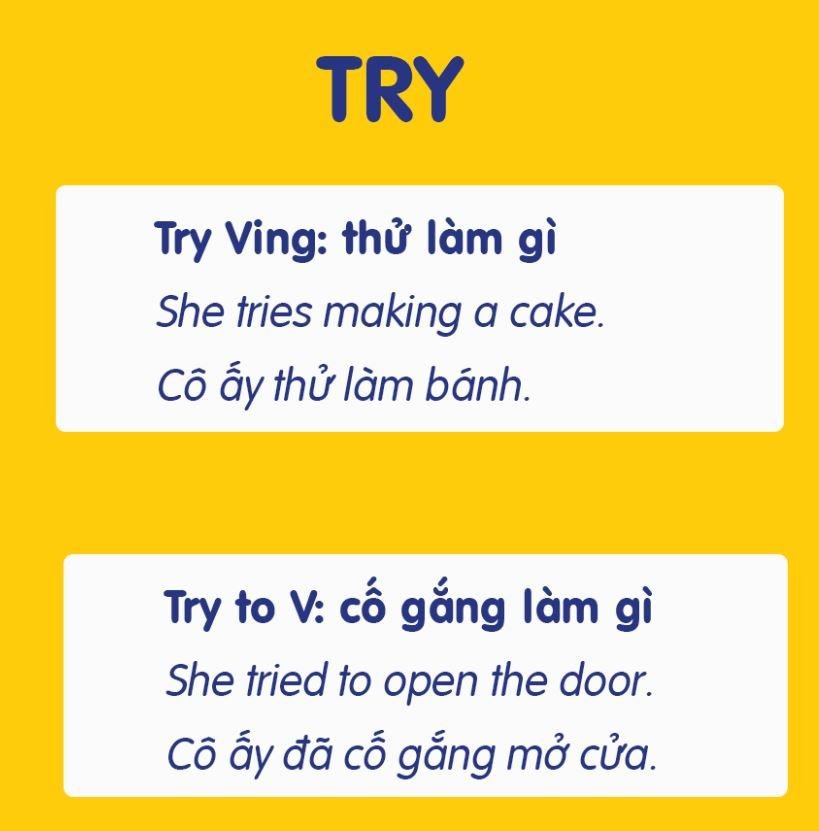
Ngoài 2 cấu trúc try cơ bản ở trên, try còn được sử dụng trong một số cụm từ sau đây.
- try something on: thử quần áo, phụ kiện,…
Ví dụ:
Yesterday afternoon, Daisy went to my shop and tried some new dresses on. After all, she decided to buy the yellow ones. / (Chiều hôm qua, Daisy đến cửa hàng của tôi và thử vài chiếc váy mới. Sau cùng thì cô ấy quyết định mua chiếc màu vàng.)
- try for: cố gắng, nỗ lực vì điều gì đó
Ví dụ:
The final match will be on the next sunday, our team has tried very hard for it. / (Trận đấu cuối cùng sẽ diễn ra vào chủ nhật tuần tới, đội của chúng tôi đã rất cố gắng vì điều đó.)
- try out: thử nghiệm điều gì đó mới
Ví dụ:
They tried out the new shampoo before it was officially launched. / (Họ đã thử nghiệm loại dầu gội đầu mới từ trước khi chúng được ra mắt.)
- Try out for something: Cạnh tranh, cố gắng cho một vị trí nào đó.
Ví dụ:
Jake is trying out for the captain of the basketball team. / (Jake đang cạnh tranh cho vị trí đội trưởng đội bóng rổ.)
- Try something out on somebody: khảo sát ý kiến của ai đó về cái gì
Ví dụ:
Their company tried out the new product on teenagers in pedestrian zones. / (Công ty của họ đã khảo sát ý kiến của những thanh thiếu niên trên phố đi bộ về sản phẩm mới.)
- Give (something) a try: thử điều gì đó, thường nói về lần đầu tiên.
Ví dụ:
I don’t think I will be good at ice skating, but I will give it a try. / (Tôi không nghĩ mình sẽ giỏi trượt băng, nhưng tôi sẽ thử xem sao.)
- Have a try/ go: cố gắng, hoặc thử điều gì mới.
Ví dụ:
- At least let me have a try, maybe I can fix it. / (Ít nhất hãy để tôi thử, biết đâu tôi có thể sửa được nó.)
- You have been standing there with the jar for twenty minutes. Let me have a go at it. / (Bạn đã đứng đó với cái hũ được 20 phút rồi đấy. Hãy để mình thử xem nào.)
Bài tập cấu trúc Try
Chọn từ thích hợp để hoàn thiện câu
- My sister has tried (making/ to make/ to made) dalgona coffee for the first time.
- Peter and his colleagues tried their best (finish/ to finish/ finishing) the task before 5 p.m.
- I think the best thing to do is try ( to remembered/ to remembering/ to remember) all the good times you had.
- I will (try to make/ tried to make/ try making) friends instead of enemies.
- She has tried (learning/ to learn/ has learnt) French for the first time and felt so excited.
- Lucy is in the dressing room. She is (trying out/ trying on/ try for) new clothes for the party tonight.
- He (tried her best for/ has tried his best on/ tried his best for) the test and got the highest mark in our class.
- Many beauty bloggers have ( tried on /tried out/ trying) our new serum and gave positive feedback.
- Doing yoga is relaxing and good for your health. You should (give it a try/ give it a moment/ make it a try).
- I tried (to call/ to calling/ called) you on your cell phone, but I didn’t get an answer.
Đáp án:
- My sister has tried making dalgona coffee for the first time.
- Peter and his colleagues tried their best to finish the task before 5 p.m.
- I think the best thing to do is try to remember all the good times you had.
- I will try to make friends instead of enemies.
- She has tried learning French for the first time and felt so excited.
- Lucy is in the dressing room. She is trying on new clothes for the party tonight.
- He tried his best for the test and got the highest mark in our class.
- Many beauty bloggers have tried out our new serum and gave positive feedback.
- Doing yoga is relaxing and good for your health. You should give it a try
- I tried to call you on your cell phone, but I didn’t get an answer.
>>> Mời xem thêm: Phân biệt cấu trúc “deny” và “refuse” trong tiếng Anh
Trong nhà bạn có biết bao nhiêu đồ đạc nhưng bạn biết bao nhiêu tên gọi tiếng Anh của chúng? Hãy cùng tìm hiểu từ vựng tiếng Anh về nhà cửa để bổ sung vốn từ của mình ngay nào!
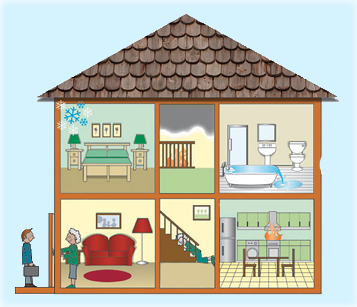
Từ vựng tiếng Anh về các loại nhà ở
House / haʊs/ nhà
Detached house /dɪˈtæʧt haʊs/ nhà biệt lập không chung tường với nhà nào
Semi-detached house /sɛmi-dɪˈtæʧt haʊs/ nhà bán biệt lập (nhà có một bên có chung tường với nhà khác)
Apartment /əˈpɑːtmənt/ căn hộ UK usually flat /flæt/
Terraced house /tɛrəst haʊs/ một nhà trong một dãy nhà
Cottage /kɒtɪʤ/ nhà ở vùng nông thôn
Bungalow /bʌŋgələʊ/ nhà gỗ một tầng
Bedsit /ˈbed.sɪt/ căn hộ khép kín 1 phòng (một phòng có đủ giường, bàn, ghế và chỗ bếp nấu)
Villa /vɪlə/ biệt thự
Timeshare /ˈtaɪm.ʃeər/ căn hộ sở hữu chung một nhóm người, mỗi người có thể sử dụng trong một thời gian/giai đoạn nhất định
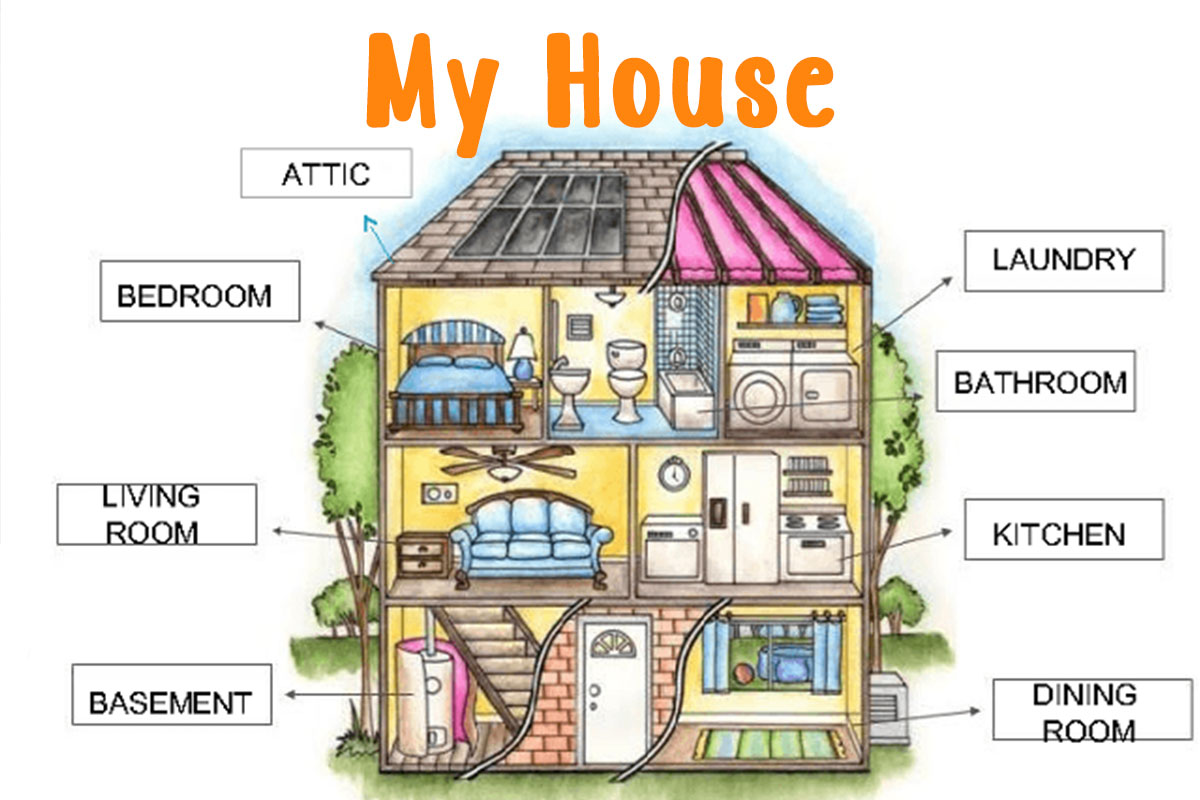
Từ vựng tiếng Anh về các phòng trong nhà ở
Bedroom /ˈbɛdru(ː)m/ phòng ngủ
Living room /ˈlɪvɪŋ ruːm/ phòng khách
Bathroom /ˈbɑːθru(ː)m/ phòng tắm
Hall /hɔːl/ phong lớn hoặc đại sảnh trong các lâu đài
Utility room /ju(ː)ˈtɪlɪti ruːm/ phòng tiện ích (như phòng tập, phòng xông hơi
Shed / ʃɛd/ nhà kho
Loft /lɒft/ tầng lửng/ gác xép chỉ để cất đồ, không để ở
Attic /ˈætɪk/ phòng gác mái
Cellar /sɛlə/ hầm chứa, kho chứa dưới hầm, không để ở
Basement /ˈbeɪsmənt/ tầng hầm để ở, phòng không có cửa sổ dưới hầm
Landing /lændɪŋ/ chiếu nghỉ
Porch /pɔːʧ/ cổng vòm, mái vòm
Pantry or larder /ˈpæntri ɔː ˈlɑːdə/ trạn để thức ăn thời xưa, trước khi có tủ lạnh
Terrace or patio /ˈtɛrəs ɔː ˈpætɪəʊ/ mái hiên, sân sau nhà nối ra vườn
Study /stʌdi/ phòng học, phòng làm việc
Balcony /bælkəni/ ban công
Garage /ˈɡær.ɑːʒ/ nhà để xe, gara
Garden /ˈɡɑː.dən/ vườn
>>> Có thể bạn quan tâm: phần mềm học tiếng anh giao tiếp trực tuyến
Từ vựng tiếng Anh về đồ dùng, vật dụng trong nhà
Remote control /rɪˈməʊt kənˈtrəʊl/ điều khiển từ xa
Power point /ˈpaʊə pɔɪnt/ ổ cắm điện
Plug /plʌg/ đầu dây cắm điện
Television /ˈtɛlɪˌvɪʒən/ ti vi, vô tuyến truyền hình
Armchair /ˈɑːmˈʧeə/ ghế bành
Chair /ʧeə/ ghế
Dining table /ˈdaɪnɪŋ ˈteɪbl/ bàn ăn
Door /dɔː/ cửa ra vào
Door handle /dɔː ˈhændl/ tay nắm cửa
Table mat /ˈteɪbl mæt/ trải bàn ăn
Wardrobe /ˈwɔːdrəʊb/ tủ bếp
Bed /bɛd/ giường
Bedside table /ˈbɛdˌsaɪd ˈteɪbl/ kệ đầu giường
Mirror /ˈmɪrə/ gương
Carpet /ˈkɑːpɪt/ thảm
Curtain /ˈkɜːtn/ rèm
Drawer /ˈdrɔːə/ ngăn kéo
Cupboard /ˈkʌbəd/ tủ (có ngăn), tủ búp phê
Towel /ˈtaʊəl/ khăn lau, khăn tắm
Bookshelf /ˈbʊkʃɛlf/ giá sách, kệ sách
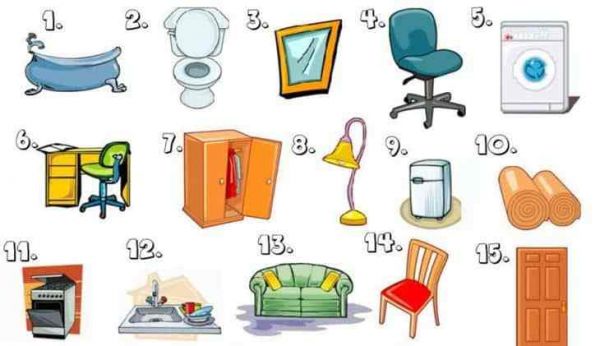
Từ vựng tiếng anh về đồ dùng trong nhà vệ sinh
Bath towel /bɑːθtaʊəl/ – khăn tắm
Bath toys: đồ chơi khi tắm (cho em bé)
Bleach /bliːtʃ/- thuốc tẩy trắng
Broom /bruːm/ – chổi
Clothes line /kləʊðz laɪn/- dây phơi quần áo
Clothes pin/kləʊðz pɪn/- cái kẹp để phơi quần áo
comb /kəʊm/ cái lược
dirty clothes hamper/ˈdɜː.ti kləʊðz ˈhæm.pəʳ/-giỏ mây đựng quần áo bẩn
dryer /ˈdraɪ.əʳ/- máy sấy khô
dustpan – /ˈdʌst.pæn/- cái hót rác
electric razor: dao cạo râu điện
Face Cloth : Khăn mặt
fly swatter /flaɪz ‘swɔtə/- vỉ ruồi
garbage /ˈgɑː.bɪdʒ/ or trash /træʃ/ – rác
hanger /ˈhæŋ.əʳ/- móc phơi
iron /aɪən/- bàn là
ironing board/ˈaɪə.nɪŋ bɔːd/- bàn để là quần áo
lighter /ˈlaɪ.təʳ/ – bật lửa
matchbook/’mætʃbʊk/- hộp diêm
Mirror : Gương soi
mop /mɒp/ – cây lau nhà
mouthwash /ˈmaʊθwɒʃ/ nước súc miệng
razor /’reizə /dao cạo râu
scrub brush /skrʌb brʌʃ/- bàn chải giặt
shampoo /ʃæmˈpuː/ – dầu gội đầu
sink /sɪŋk/ – bồn rửa mặt
soap /səʊp/ – xà phòng
sponge /spʌndʒ/ – miếng bọt biển
spray bottle /spreɪ ˈbɒt.ļ/- bình xịt
toilet paper : giấy vệ sinh
toothbrush /ˈtuːθ.brʌʃ/ – bàn chải đánh răng
towel /’tauəl/ khăn tắm
trash bag /træʃ bæg/-bao đựng rác
trash can/træʃ kæn/- thùng rác
vacuum cleaner/ˈvæk.juːm ˈkliː.nəʳ/- máy hút bụi
washcloth /ˈwɒʃ.klɒθ/ – khăn mặt
washing machine/wɑʃɪŋ məˈʃiːn/: máy giặt
Cụm từ Tiếng Anh về trang trí nhà cửa
Decorating /’dekəreit/ trang trí
Hang/put up wallpaper: treo/dán tường
Throw out/replace the old light fittings: thay thế mới hệ thống ánh sáng(đèn)
Fit/put up blind or curtains: lắp rèm (rèm chắn sáng – blinds, rèm thông thường – curtains)
Give something a lick/a coat of paint: sơn tường nhà
Go for a … effect: tạo ra một hiệu ứng hình ảnh có tên…
Put the finishing touches to: hoàn thiện phần trang trí chi tiết cuối cùng
Cụm từ tiếng Anh khi muốn nói sửa sang
Be handy around the house: chăm chỉ làm việc nhà, khiến cho ngôi nhà sạch sẽ
Build a patio: làm một chiếc sân nhỏ trong nhà
Convert the loft: chuyển đổi gác xép thành nơi có thể ở được
Diy: tự làm
Draw up plans: lập kế hoạch
Get planning/building permission: xin giấy phép chính quyền để sửa nhà
Have an extension: mở rộng
Instal central heating/solar panels: lắp mới hệ thống sưởi ấm
Knock down a wall: đập bỏ một bức tường
Knock through from the kitchen: thông tường nhà bếp
Put in a conservatory / a fitted kitchen / a new bathroom: xây thêm một phòng phụ/một bếp phụ/một phòng tắm mới.
Renovation: sửa sang
Re-plaster the ceiling: chát lại tường
Rewire the house: lắp mới đường dây điện
Turn the dining room into a spare bedroom: chuyển phòng ăn thành phòng ngủ phụ
Mẫu câu giới thiệu Tiếng Anh về chủ đề nhà cửa

In my house, there is/are… – Trong nhà tôi có …
In my house, there are five rooms, one bedroom, one living room, one kitchen, one bathroom and one hall – Trong nhà tôi, có 5 phòng, một phòng ngủ, một phòng khách, một phòng bếp, một phòng tắm và một sảnh.
My house/apartment/flat is located/situated/in + name of a place – Nhà/căn hộ của mình ở/tọa lạc/trong + tên địa điểm
My apartment is in a very beautiful building in Times City – Căn hộ của mình trong một tòa nhà rất đẹp ở Times City.
My flat is well situated in a small village called Flower village – Nhà tớ nằm gọn trong một ngôi làng nhỏ tên là tọa lạc trong một thị trấn nhỏ tên làng Hoa.
Even though I live in a small house, I look forward to going home at the end of a long day. – Mặc dù sống trong một ngôi nhà nhỏ nhưng mình luôn mong ngóng trở về tổ ấm của mình sau một ngày dài.
>>> Mời xem thêm: Từ vựng chủ đề đồ ăn trong tiếng Anh bạn nên biết
Hầu hết các bé thường ưa thích các bài hát thiếu nhi vui nhộn. Vì thế, phụ huynh có thể giúp các bé nghe các bài hát thiếu nhi tiếng Anh để học tập ngôn ngữ này một cách tự nhiên.
Top 16 bài hát tiếng Anh cho bé
1. Once I caught A fish Alive – Bài hát tiếng Anh cho bé tập đếm
“Once I caught A fish Alive” là bài hát tiếng Anh cho bé tập đếm. Nội dung kể về một cậu bé muốn tìm một chú cá về nuôi để làm bạn.
Để thực hiện mơ ước của mình, cậu bé ra bờ sông bắt cá và thả vào trong một chiếc chậu. Trong một lần nựng yêu chú cá, cậu chẳng may bị cá cắn vào ngón tay út.
Thế là cậu bé giận dỗi và thả chú cá trở về lại dòng sông.
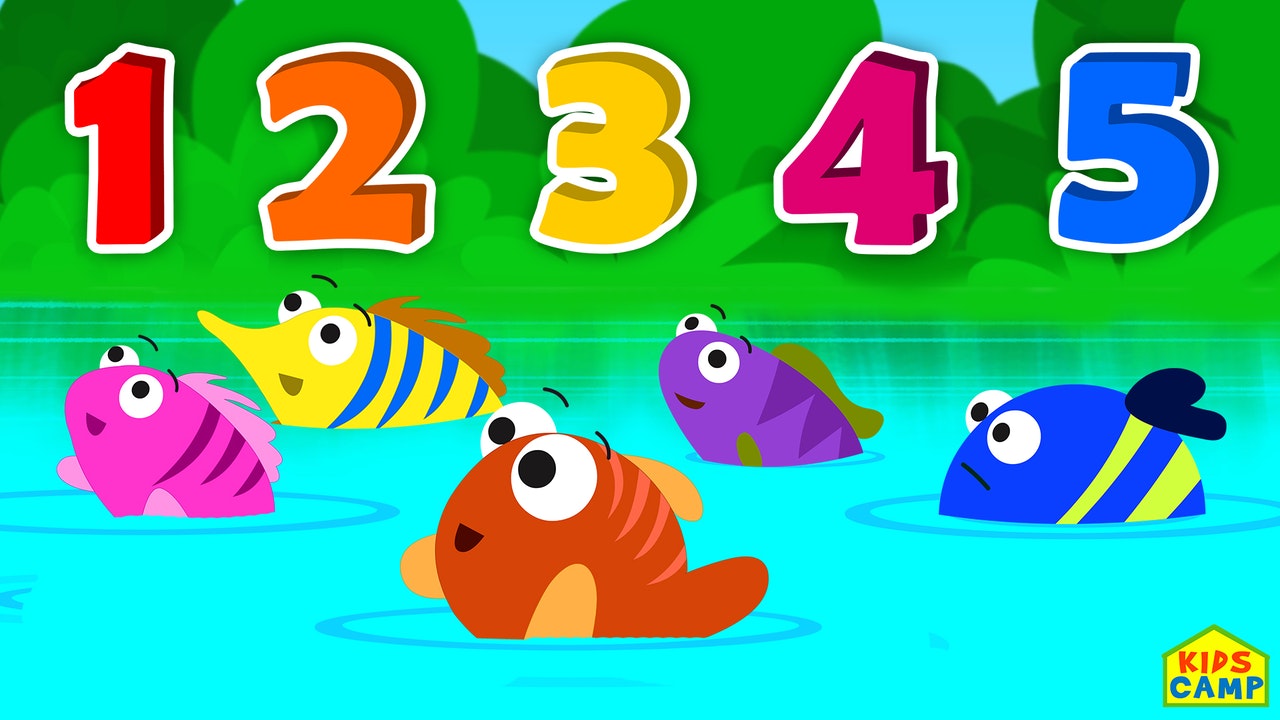
* Lời bài hát:
One, two, three, four, five
Once I caught a fish alive,
Six, seven, eight, nine, ten,
Then I let it go again.
Why did you let it go?
Because it bit my finger so.
Which finger did it bite?
This little finger on my right.
2. The Alphabet Song – Bài hát tiếng Anh cho bé học bảng chữ cái
Chắc không cần phải giới thiệu nhiều, bài hát tiếng Anh cho bé “The Alphabet Song” sẽ dạy các bé học phát âm bảng chữ cái tiếng Anh.
* Lời bài hát:
A B C D E F G
H I J K L M N
O P Q R S T U
V W X Y Z
Now I know my ABCs
Next time won’t you sing with me!
3. A Sailor Went To Sea – Bài hát tiếng Anh dạy bé phân biệt từ đồng âm
Bài hát tiếng Anh “A Sailor Went To Sea” chú trọng dạy bé phân biệt ý nghĩa khác nhau giữa hai từ đồng âm see và sea.
sea /si:/ – see /si:/
* Lời bài hát:
A sailor went to sea, sea, sea
To see what he could see, see, see
But all that he could see, see, see
Was the bottom of the deep blue sea, sea, sea!
A sailor went to knee, knee, knee
To see what he could knee, knee, knee
But all that he could knee, knee, knee
Was the bottom of the deep blue knee, knee, knee!
Sea, sea, sea
4. Bingo – Bài hát tiếng Anh dạy cho bé cách đánh vần tên riêng
Thông qua câu chuyện về một chú chó tên là Bingo sống trong một nông trại, bài hát tiếng Anh Bingo dạy cho bé cách đánh vần tên riêng của một đối tượng.
* Lời bài hát:
There was a farmer who had a dog,
And Bingo was his name-O.
B-I-N-G-O!
B-I-N-G-O!
B-I-N-G-O!
And Bingo was his name-O!
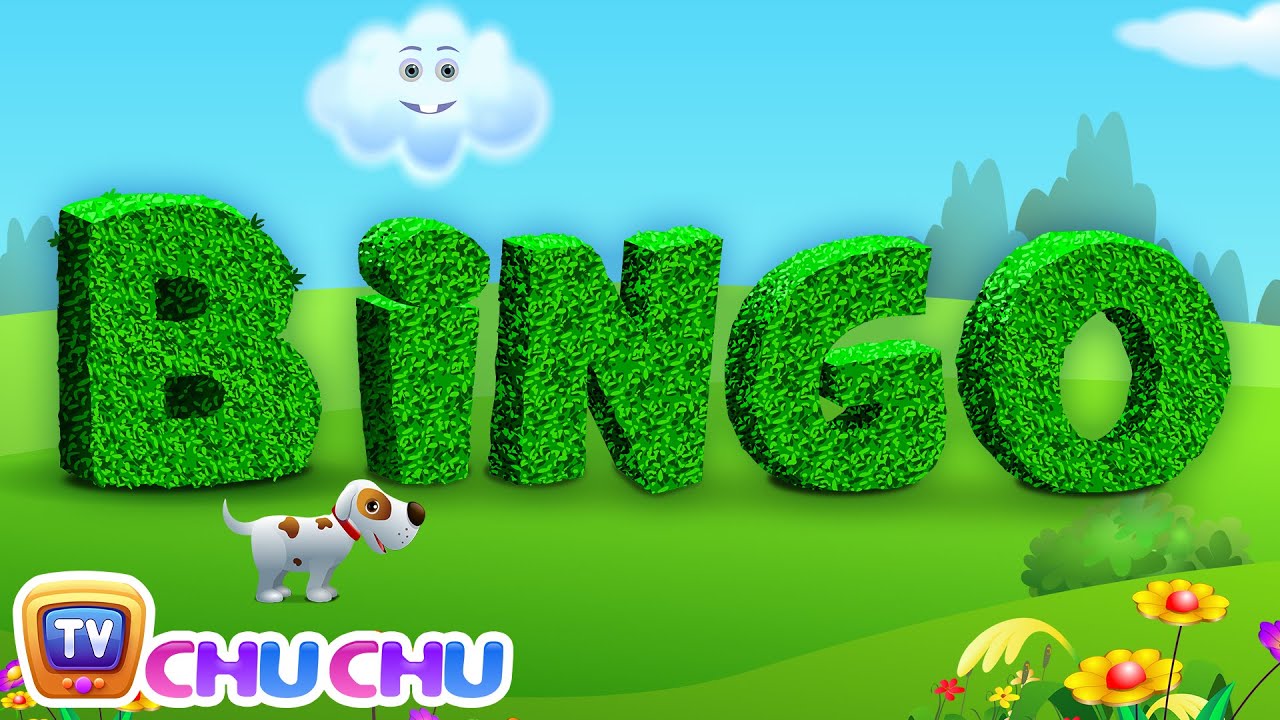
5. Baa Baa Black Sheep – Cừu đen Baa Baa
Bài hát cừu đen Baa Baa, bạn có thể dạy bé cách sử dụng câu hỏi “Have you any…?”, cũng như câu hỏi “Do you have any…?”.
Cả “Do you have any…?” và “Have you any…?” đều có ý nghĩa như nhau, nhưng “Do you have any…?” được sử dụng thường xuyên hơn.
* Lời bài hát:
Baa, baa black sheep
Have you any wool
Yes sir, yes sir
Three bags full.
One for my master
And one for my dame
And one for the little boy
Who lives down the lane.
6. Bài hát tiếng Anh cho bé: “Head Shoulders Knees and Toes”
Bài hát tiếng Anh cho bé “Head, shoulders, knees and toes” đơn giản là dạy bé về các bộ phận trên cơ thể người.
Head, shoulders, knees and toes,
Knees and toes.
Head, shoulders, knees and toes,
Knees and toes.
And eyes, and ears, and mouth, and nose.
Head, shoulders, knees and toes,
Knees and toes.
>>> Có thể bạn quan tâm: học tiếng anh giao tiếp online miễn phí hiệu quả
7. Hey Diddle Diddle – Này Diddle Diddle
Bài hát tiếng Anh cho bé “Diddle Diddle” kể về giấc mơ của cô bé có tên là Diddle Diddle. Trong mơ cô bé thấy những người bạn thân thiết của mình, một chú mèo kéo đàn vi-ô-lông để cho chú bò nhảy múa trên cung trăng, cả con chó, cái đĩa và cái muỗng trong nhà ăn.
* Lời bài hát:
Hey diddle diddle,
The cat and the fiddle,
The cow jumped over the moon.
The little dog laughed to see such sport,
And the dish ran away with the spoon.
8. Bài hát tiếng Anh cho bé: “Hickory Dickory Dock”
Trong bài hát Hickory Dickory Dock, các bé sẽ được dạy về thì quá khứ đơn.
Ví dụ: The mouse ran up the clock
* Lời bài hát:
Hickory Dickory Dock
The mouse ran up the clock
The clock struck one
The mouse ran down
Hickory Dickory Dock
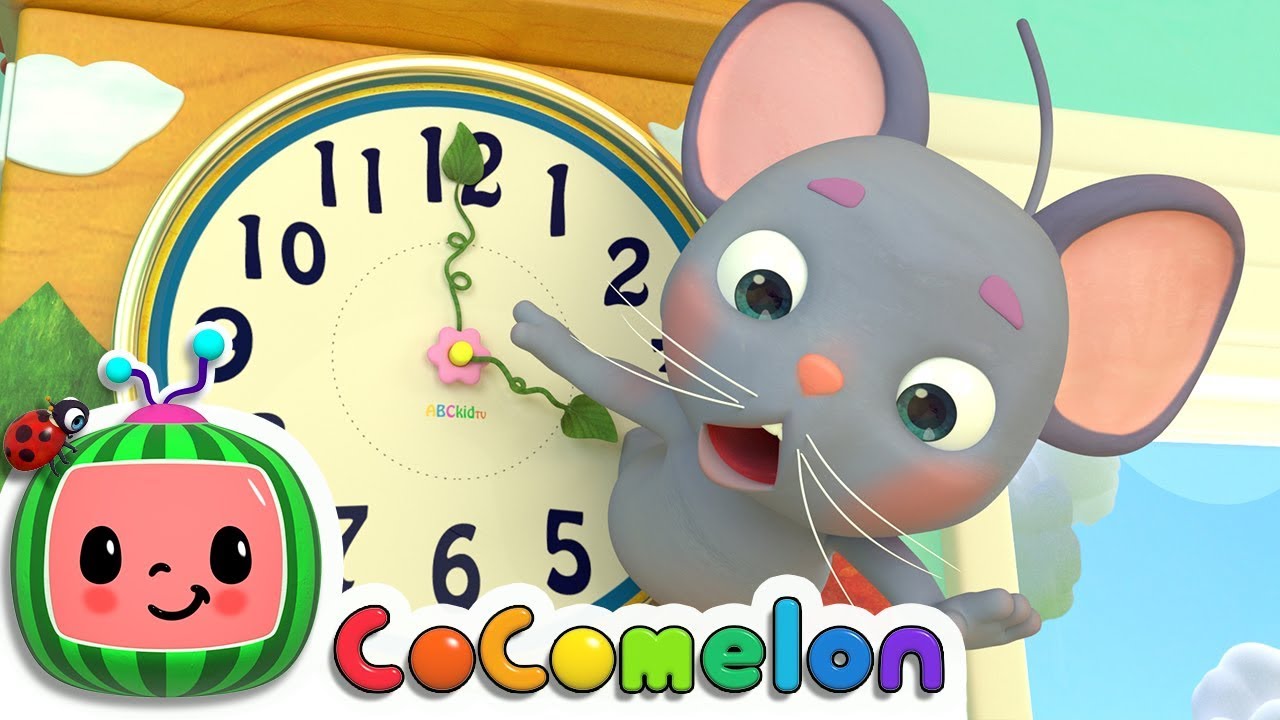
9. Humpty Dumpty – Cậu quả trứng Humpty Dumpty
Bài hát tiếng Anh cho bé thứ 9 là bài hát về một nhân vật nổi tiếng trong truyện cổ tích ở châu Âu
Bài hát kể về Cậu quả trứng Humpty Dumpty ngồi trên bức tường cao, chẳng may bị té ngã và vở ra từng mảnh. Tất cả những người lính và bầy ngựa nhìn thấy nhưng không giúp gì được cho Humpty Dumpty.
Humpty Dumpty sat on a wall,
Humpty Dumpty had a great fall.
All the King’s horses and all the King’s men,
Couldn’t put Humpty together again.
10. Hush, Little Baby – Ngủ ngon nghe con
Bài hát tiếng Anh cho bé thứ 10 (Hush, little baby) là một bài hát ru con nổi tiếng của Mỹ.
Hiện tại có rất nhiều biến thể khác nhau của bài hát ru “Hush, little baby”.
* Lời bài hát:
Hush, little baby, don’t say a word,
Papa’s gonna buy you a mockingbird.
And if that mockingbird don’t sing,
Papa’s gonna buy you a diamond ring.
And if that diamond ring turn brass,
Papa’s gonna buy you a looking glass.
And if that looking glass gets broke,
Papa’s gonna buy you a billy goat.
And if that billy goat don’t pull,
Papa’s gonna buy you a cart and bull.
And if that cart and bull turn over,
Papa’s gonna buy you a dog named Rover.
And if that dog named Rover won’t bark.
Papa’s gonna to buy you and horse and cart.
And if that horse and cart fall down,
Well you’ll still be the sweetest little baby in town.
11. I’m a Little Teapot – Ấm trà bé con
“I’m a little teapot” là bài hát tiếng Anh cho bé thứ 11. Nội dung ca từ lời tự sự của một chiếc ấm trà bé con.
* Lời bài hát dành cho bé:
I’m a little teapot
Short and stout
Here is my handle
Here is my spout.
When I get all steamed up
Hear me shout
“Tip me over
and pour me out!’.
12. Bài hát tiếng Anh cho bé: “If You’re Happy and You Know It”
Bài hát tiếng Anh cho bé thứ 12 có tên là “If You’re Happy and You Know It”.
Đây là một bài hát truyền thống dùng để dạy trẻ nhỏ thể hiện cảm xúc trên gương mặt. Vì vậy, hãy dạy bé hát theo ca sĩ và thể hiện cảm xúc như các nhân vật hoạt hình trong video nhé.

* Lời bài hát tiếng Anh:
If You’re Happy and You Know It
If you’re happy and you know it, clap your hands.
(clap clap)
If you’re happy and you know it, clap your hands.
(clap clap)
If you’re happy and you know it, and you really want to show it.
If you’re happy and you know it, clap your hands.
(clap clap)
If you’re happy and you know it stamp your feet.
(Stomp Stomp)
If you’re happy and you know it stamp your feet.
(Stomp Stomp)
If you’re happy and you know it, and you really want to show it.
If you’re happy and you know it, stomp your feet
(Stomp Stomp)
If you’re happy and you know it, shout hurray
Hurray
If you’re happy and you know it, shout hurray
Hurray
If you’re happy and you know it, and you really want to show it
If you’re happy and you know it, shout hurray
Hurray
If you’re happy and you know it, clap your hands (clap clap)
Stomp your feet (stomp stomp)
Shout hurray “Hurray”
If you’re happy and you know it, and you really want to show it
If you’re happy and you know it, clap your hands (clap clap)
Stomp your feet (stomp stomp)
Shout hurray “Hurray”
13. Bài hát tiếng Anh cho bé: “Incy wincy spider”
Bài hát tiếng Anh cho bé thứ 13 có tên là “Incy wincy spider”. Đây là bài hát được trẻ em trên toàn thế giới ưa thích. Ngoài ra nó còn có một tên khác là “Itsy Bitsy Spider”.
Nội dung bài hát kể về một chú nhện cố gắng trèo lên ống thoát nước trong lúc trời mưa tầm tã. Mỗi khi nhện cố gắng bò lên ống là lại bị nước đẩy trôi trở lại mặt đất.
* Lời bài hát tiếng Anh:
Incy wincy spider
climbed up the water spout,
Down came the rain
and washed poor Wincy out,
Out came the sun shine
and dried up all the rain,
And Incy Wincy spider
climbed up the spout again.
14. Bài hát tiếng Anh cho bé: “Jack and Jill”
Bài hát tiếng Anh cho bé thứ 14 có nội dung kể về chị em nhà chuột Jack and Jill lên đồi xách nước hộ mẹ.
Sau khi mang nước về nhà, cả hai chị em được mẹ thưởng cho một buổi tắm rửa sạch sẽ và thơm mát.
* Lời bài hát tiếng Anh:
Jack and Jill went up the hill
To fetch a pail of water.
Jack fell down and broke his crown,
And Jill came tumbling after.
Up Jack got and home did trot
As fast as he could caper;
And went to bed to mend his head
With vinegar and brown paper.
15. Bài hát tiếng Anh cho bé: “5 Little Monkeys Jumping on the Bed”
Bài hát tiếng Anh cho bé thứ 15 kể về 5 chú khỉ nhỏ nghịch ngợm nhảy nhót trên giường ngủ. Chẳng may, từng chú ngã lăn xuống đất làm khỉ mẹ phải gọi ngay cho bác sĩ.
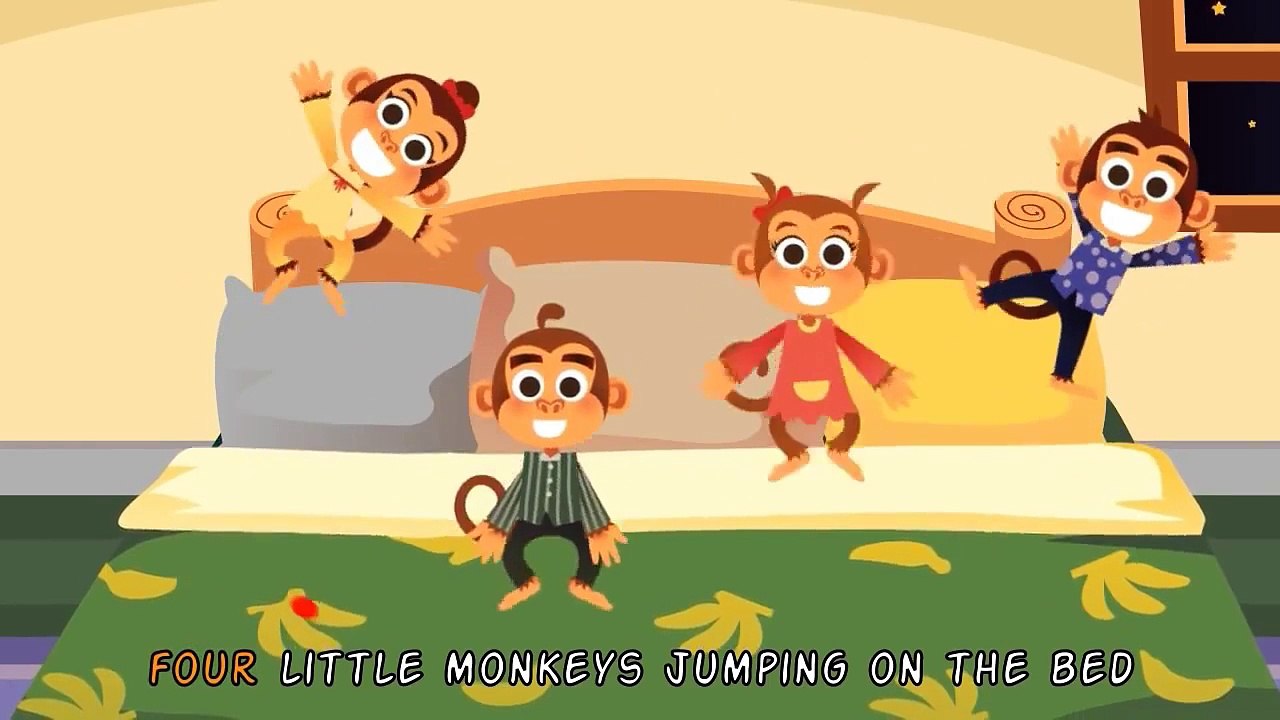
* Lời bài hát tiếng Anh:
Five little monkeys jumping on the bed,
One fell off and bumped his head,
So Momma called the doctor and the doctor said,
No more monkeys jumping on the bed.
Four little monkeys jumping on the bed
One fell off and bumped his head
So Momma called the doctor and the doctor said
No more monkeys jumping on the bed!
Three little monkeys jumping on the bed
One fell off and bumped his head
So Momma called the doctor and the doctor said
No more monkeys jumping on the bed!
Two little monkeys jumping on the bed
One fell off and bumped his head
So Momma called the doctor and the doctor said
No more monkeys jumping on the bed!
One little monkey jumping on the bed
He fell off and bumped his head
So Momma called the doctor and the doctor said
No more monkeys jumping on the bed!
16. Bài hát tiếng Anh cho bé: “Miss Polly Had A Dolly”
Bài hát tiếng Anh cho bé thứ 16 là câu chuyện kể về trò chơi bác sĩ của hai em nhỏ Dave và Ava.
* Lời bài hát tiếng Anh:
Miss Polly Had A Dolly
Miss Polly had a dolly who was sick, sick, sick.
So she phoned for the doctor to be quick, quick, quick.
The doctor came with his bag and hat,
And knocked at the door with a rat tat tat.
He looked at the dolly and shook his head,
And said “Miss Polly put her straight to bed.”
He wrote a pad for a pill, pill, pill.
I’ll be back in the morning with my bill, bill, bill
>>> Mời xem thêm: Cách trả lời các câu hỏi phỏng vấn tiếng Anh gây ấn tượng với nhà tuyển dụng
Khi bắt đầu lựa chọn một công việc mới và ứng tuyển vào vị trí làm việc thì vòng phỏng vấn đóng vai trò quan trọng giúp bạn chứng tỏ được năng lực của mình, tạo được ấn tượng với nhà tuyển dụng. Đặc biệt với các công ty nước ngoài, một buổi phỏng vấn chỉ kéo dài khoảng 20 phút nhưng vô cùng quan trọng để nhà tuyển dụng đánh giá năng lực của bạn. Dưới đây là cách trả lời phỏng vấn tiếng Anh hay và gây ấn tượng tốt nhất đến người đọc.

1. How would you describe yourself ? – Anh/Chị miêu tả bản thân mình như thế nào
(Tương tự: What are your strengths/positive traits? Why should we hire you?)
- I consider myself hardworking/reliable/dependable/helpful/outgoing/organized /honest/cooperative. (Tôi thấy mình là người chăm chỉ/đáng tin/trung thực/được việc/hướng ngoại/làm việc có tổ chức)
- I’m a team-player/an experienced team-leader/a seasoned (experienced) professional/a dedicated worker. (Tôi là người có tinh thần đồng đội/một trưởng nhóm có kinh nghiệm/chuyên gia nhiều kinh nghiệm/nhân viên tận tụy)
- I’m good at dealing with people/handling stress. (Tôi giỏi thỏa hiệp với mọi người/giải quyết vấn đề áp lực)
- I pay attention to details. (Tôi là người chú trọng tiểu tiết)
- I understand my customers’ needs. (Tôi hiểu khách hàng của mình cần gì)
- I learn quickly and take pride in my work. (Tôi tiếp thu nhanh và tự hào về những gì mình làm được)
- I love challenges and getting the job done. (Tôi thích thử thách và yêu cảm giác hoàn thành nhiệm vụ)
2. What kind of qualifications do you have? – Anh/ Chị có những bằng cấp gì?
- I graduated in IT from the University of London. (Tôi tốt nghiệp ngành IT ở Đại học London)
- I hold a master’s degree (MA)/a bachelor’s degree (BA) in Modern Languages from the University of New York. (Tôi sở hữu bằng thạc sĩ/cử nhân ngành Ngôn ngữ Hiện đại của Đại học New York)
- I took one year accounting training program at Oxford College. (Tôi dành một năm cho chương trình kế toán ở Cao đẳng Oxford)
- I haven’t done any formal training for this job, but I have worked in similar positions and have ten years of experience in this field. (Tôi không được đào tạo bài bản cho công việc này nhưng tôi đã từng đảm nhận vị trí tương tự và có 10 năm kinh nghiệm trong lĩnh vực này)

3. Why did you leave your last job? - Vì sao anh nghỉ công việc trước?
- I was laid off/made redundant, because the company relocated/downsized /needed to cut costs. (Tôi đã bị cho nghỉ việc/trở thành nhân sự thừa vì công ty tái cơ cấu/thu nhỏ quy mô/cần cắt giảm chi phí)
- I wanted to focus on finding a job that is nearer to home/that represents new challenges/where I can grow professionally. (Tôi muốn tìm một công việc gần nhà hơn/mang đến những thử thách mới/giúp tôi phát triển một cách chuyên nghiệp)
>>> Có thể bạn quan tâm: các trang web học tiếng anh online hiệu quả
4. What do you do in your current role? - Vai trò ở công việc hiện tại của Anh/ Chị là gì?
- I’m responsible for the recording and conveying messages for the departments. (Tôi chịu trách nhiệm ghi âm và chuyển tin nhắn đến các phòng)
- I ensure that high standard of customer care is maintained. (Tôi đảm bảo việc duy trì chất lượng chăm sóc khách hàng)
- I liaise with the Business Development and Business Services Units. (Tôi kết nối hai đơn vị dịch vụ kinh doanh và phát triển kinh doanh với nhau)
- I deal with incoming calls and correspond with clients via emails. (Tôi giải quyết các cuộc gọi tới và trả lời khách hàng thông qua email)
- I’m in charge of the high-priority accounts. (Tôi có trách nhiệm với những tài khoản cần ưu tiên)
5. What relevant experience do you have? – Anh/ Chị có kinh nghiệm gì liên quan tới công việc?
Lưu ý: nên sử dụng thì Hiện tại Hoàn thành hoặc Hiện tại Hoàn thành Tiếp diễn để nói về những kinh nghiệm mình từng có trong quá khứ và vẫn đang tiếp tục ở hiện tại
- I have worked as a Sales Representative for several years. (Tôi từng đảm nhiệm vị trí Đại diện Kinh doanh trong nhiều năm qua)
- I have great people skills: I’ve been working in Customer Service and been dealing with complaints for five years. (Tôi có kỹ năng làm việc tốt với mọi người vì từng làm ở bộ phận dịch vụ khách hàng và giải quyết các khiếu nại trong năm)
6. Why would you like to work for us? - Vì sao Anh/ Chị mong muốn làm việc cho chúng tôi?
- I would like to put into practice what I learned at university. (Tôi mong muốn được áp dụng những gì được học ở trường vào thực tế)
- I’ve always been interested in E-Commerce/Marketing/and your company excels (is one of the best) in this field. (Tôi luôn quan tâm đến thương mại điện tử/marketing và công ty của ông đi đầu trong lĩnh vực này)

7. What are your weaknesses/negative traits?
- I’m a perfectionist and I may be too hard on myself or my co-workers sometimes. (Tôi là người theo chủ nghĩa hoàn hảo và có lúc quá hà khắc với bản thân và đồng nghiệp)
- I might need to learn to be more flexible when things are not going according to plan. (Tôi nên học cách trở nên linh động hơn khi mọi thứ không như kế hoạch)
- I occasionally focus on details instead of looking at the bigger picture. I’m learning how to focus on the overall progress as well. (Thi thoảng, tôi bị quá chú tâm vào chi tiết và không chú ý đến toàn cảnh. Tôi đang học cách nhìn vào toàn quá trình)
8. When can you commence employment with us? - Khi nào Anh/ Chị có thể bắt đầu làm việc với chúng tôi?
(Tương tự: When can you start work?)
- I will be available for work in January, next year. (Tôi sẵn sàng cho công việc này vào tháng một năm sau)
- I can start immediately. (Tôi có thể bắt đầu ngay)
- I have to give three weeks’ notice to my current employer, so the earliest I can start is the first of February. (Tôi cần 3 tuần để thông báo với sếp hiện tại, vì vậy, tôi có thể bắt đầu sớm nhất vào 1/2)
9. Do you have any questions? – Anh/ Chị còn câu hỏi nào nữa không?
- What would be the first project I’d be working on if I was offered the job? (Nếu tôi được nhận công việc này, dự án đầu tiên mà tôi được tham gia là gì?)
- Who would I report to? Who would I be working closely with? (Tôi sẽ báo cáo công việc với ai? Tôi sẽ làm việc nhiều với ai?)
- When will I get an answer? How soon can I start? (Khi nào tôi sẽ nhận được kết quả? Tôi có thể bắt đầu đi làm từ khi nào?)
>>> Mời xem thêm: Top 3 cách để bắt chuyện với người lạ bằng tiếng Anh hiệu quả nhất







